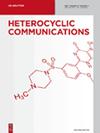金属-有机纳米纤维/氧化石墨烯纳米复合材料电化学测定次黄嘌呤传感元件的合成
IF 1.5
3区 化学
Q3 CHEMISTRY, ORGANIC
引用次数: 0
摘要
摘要本研究采用金属有机纳米纤维(MONFs)和还原氧化石墨(rGO)纳米复合材料修饰玻碳电极表面,并将电化学传感器应用于差分脉冲伏安法测定人体嘌呤降解代谢氧化中间体次黄嘌呤。MONFs/rGO纳米复合材料的制备简单、高效、环保。采用场发射扫描电镜和x射线衍射对MONFs/rGO纳米复合材料的形貌和结构进行了表征。结果表明,改进后的传感器电流密度显著提高,线性范围为0.1 ~ 10 μM和20 ~ 100 μM。检测限为0.01 μM (S / N = 3)。在优化条件下,改进后的传感器具有良好的稳定性、选择性和精度。本文章由计算机程序翻译,如有差异,请以英文原文为准。
Synthesis of metal–organic nanofiber/rGO nanocomposite as the sensing element for electrochemical determination of hypoxanthine
Abstract In this study, metal–organic nanofibers (MONFs) and reduced graphite oxide (rGO) nanocomposite were used to modify the surface of glassy carbon electrode, and the electrochemical sensor was applied to the differential pulse voltammetry determination of hypoxanthine, the oxidation intermediate of human purine degradation metabolism. The preparation of MONFs/rGO nanocomposite is simple, efficient, and environmentally friendly. The morphology and structure of MONFs/rGO nanocomposite were characterized by field emission scanning electron microscopy and X-ray diffraction. The results show that the improved sensor has a significant increase in current density, with linear ranges of 0.1–10 and 20–100 μM. Detection limit 0.01 μM ( S / N = 3). Under the optimized conditions, the improved sensor shows very good stability, selectivity, and improved accuracy.
求助全文
通过发布文献求助,成功后即可免费获取论文全文。
去求助
来源期刊

Heterocyclic Communications
化学-有机化学
CiteScore
3.80
自引率
4.30%
发文量
13
审稿时长
1.4 months
期刊介绍:
Heterocyclic Communications (HC) is a bimonthly, peer-reviewed journal publishing preliminary communications, research articles, and reviews on significant developments in all phases of heterocyclic chemistry, including general synthesis, natural products, computational analysis, considerable biological activity and inorganic ring systems. Clear presentation of experimental and computational data is strongly emphasized. Heterocyclic chemistry is a rapidly growing field. By some estimates original research papers in heterocyclic chemistry have increased to more than 60% of the current organic chemistry literature published. This explosive growth is even greater when considering heterocyclic research published in materials science, physical, biophysical, analytical, bioorganic, pharmaceutical, medicinal and natural products journals. There is a need, therefore, for a journal dedicated explicitly to heterocyclic chemistry and the properties of heterocyclic compounds.
 求助内容:
求助内容: 应助结果提醒方式:
应助结果提醒方式:


